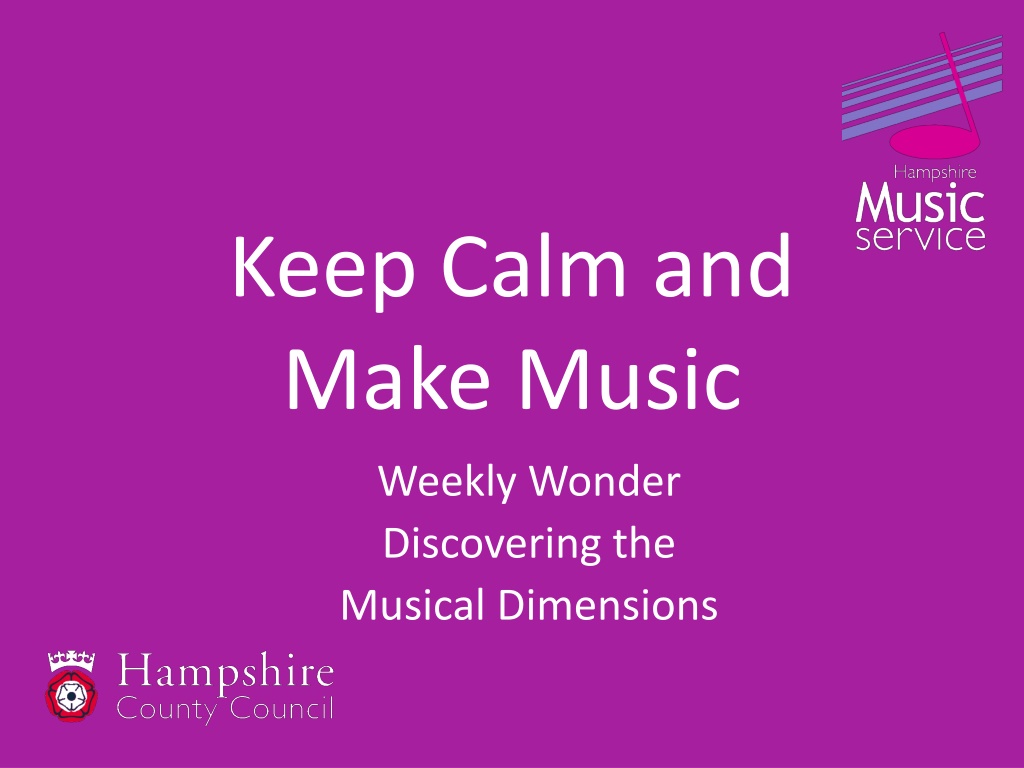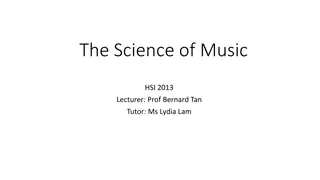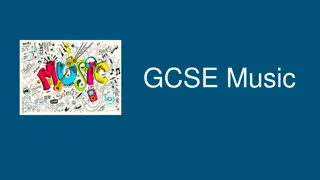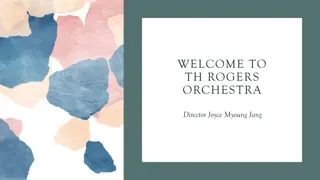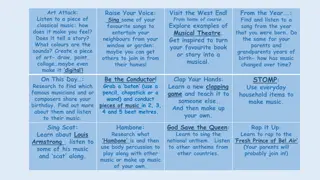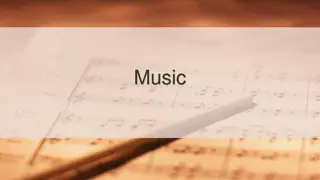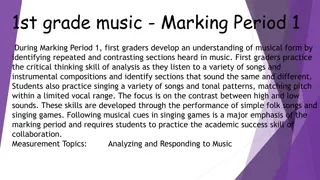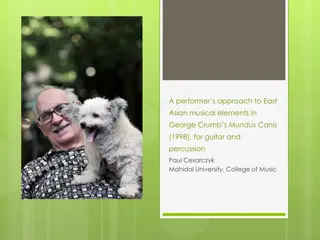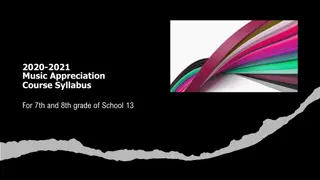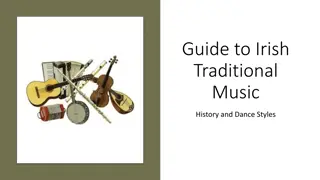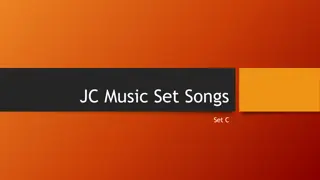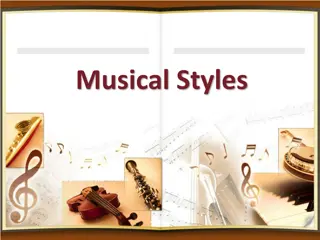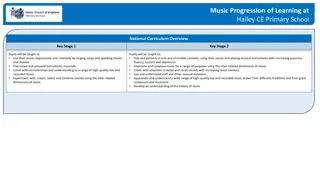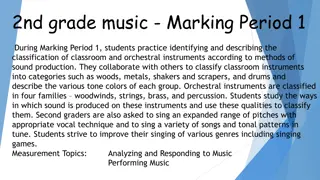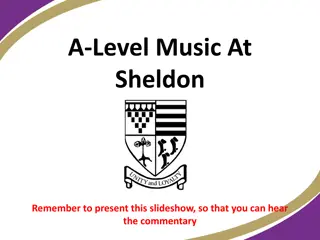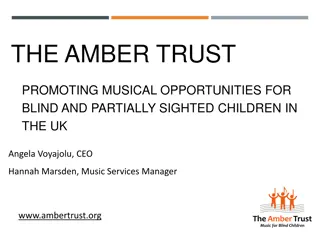Explore the Musical Dimensions: Keep Calm and Make Music Weekly
Discover the seven musical dimensions through fun activities such as exploring pitch, duration, dynamics, tempo, structure, texture, and timbre. Engage in creating tunes, making instruments, and learning about scales to enhance your musical knowledge and skills.
Download Presentation

Please find below an Image/Link to download the presentation.
The content on the website is provided AS IS for your information and personal use only. It may not be sold, licensed, or shared on other websites without obtaining consent from the author. Download presentation by click this link. If you encounter any issues during the download, it is possible that the publisher has removed the file from their server.
E N D
Presentation Transcript
Keep Calm and Make Music Weekly Wonder Discovering the Musical Dimensions
Tempo Pitch Duration Dynamics Discovering the Musical Dimensions Timbre Texture Structure
Contents homepage Click on the to return to this page C:\Users\HMS\AppData\Local\Microsoft\Windows\INetCache\IE\5BD2DBGR\j0442122[1].png There are seven musical dimensions one for every day of the week! Which one will you discover today? Click on a dimension and off you go Pitch what it means and fun pitch activities Duration what it means and fun duration activities Dynamics what it means and fun dynamic activities Tempo what it means and fun tempo activities Structure what it means and fun structure activities Texture - what it means and fun texture activities Timbre what it means and fun timbre activities Quiz time Don t try and do them all in one go it could be a bit
PITCH is all about how high or low sounds are and how notes are grouped into sets called scales Key words High, middle and low Higher and lower Scale Click here to find out why some sounds are higher than others Click here to find out how notes are grouped into scales
Fun pitch activities Click here to have fun using pitched sounds to invent your own tune Use this online virtual piano to explore high and low sounds on a keyboard (left hand side for low and right hand side for high) Turn the mapping dial to real and use your computer keyboard to play the notes. If you click the sounds button you will be able to choose from different types of sounds to use. See if you can play a well known tune e.g. Twinkle Twinkle Little Star What other tunes can you play?
Try making an instrument that will play high and low sounds D:\OneDrive - Hampshire County Council\Documents\HMS\clipart\Home made instruments\straws 2.jpg Click here to find out how to make a blown instrument Other ideas for instruments that will play high and low sounds C:\Users\HMS\AppData\Local\Microsoft\Windows\INetCache\IE\5BD2DBGR\j0442122[1].png
DURATION is all about how long and short sounds are, beat, rhythm and metre Key words Long and short Steady beat Rhythm pattern Metre 1 2 or 1 2 3 or 1 2 3 4 Click here to find out about the steady beat Click here to find out about rhythm Music beats are usually counted in groups. Metre is how many beats the music is being counted in e.g. 1 2 3 4 = 4 metre, 1 2 3 = 3 metre and 1 2 = 2 metre Click here to listen to a woodblock being played in 2, 3 then 4 metre at different speeds. Try clapping on beat number 1 for each example
Fun duration activities Listen to Only time will tell by Mike Oldfield Tap along to the steady beat (beep) on your thighs? To create two possible 4 metre beet and cherry rhythm patterns click for 8 beats and then tap along to the music e.g. 1 2 3 4 1 2 3 4 or
Play guess the metre 2, 3 or 4? Listen to the following pieces of music. Can you guess their metre? (Find the answers in the notes for this slide) Piece 1 Piece 2 Piece 3 C:\Users\HMS\AppData\Local\Microsoft\Windows\INetCache\IE\5BD2DBGR\j0442122[1].png
DYNAMICS is all about how loud or quiet sounds are Key words Loud and quiet Forte and piano Getting louder and quieter Crescendo and decrescendo Click here to find out about forte, piano, crescendo and decrescendo
Fun dynamic activities Listen to the March Past of the Kitchen Utensils Tiptoe around the room when the music is quiet Clap loudly on the cymbal crash Once you have got to know the music find something you can make a loud clashing sound with and join in with the cymbal Listen to Time from the sound track of the movie Inception. Curl up in a ball on the floor for the start of the music and gradually uncurl and grow as the music crescendos - what will you do at the end as the music decrescendos? C:\Users\HMS\AppData\Local\Microsoft\Windows\INetCache\IE\5BD2DBGR\j0442122[1].png
TEMPO is all about how fast or slow the music is Key words Fast and slow Presto and largo Getting faster and slower Accelerando and rallantando Click here to find out about fast and slow sounds Presto means fast and largo means slow
Fun tempo activities Join in with Baby Shark How fast can you sing? Can you keep up? Clap or dance along with this flash mob version of Zorba the Greek
Play the presto largo quiz Listen to the following pieces of music. Are they presto or largo? (Find the answers in the notes for this slide) Piece 1 Piece 2 C:\Users\HMS\AppData\Local\Microsoft\Windows\INetCache\IE\5BD2DBGR\j0442122[1].png
STRUCTURE is all about the order sounds happen in Key words Beginning, middle, ending Call and echo, Call and response Verse, chorus Ternary (ABA) Round Theme and variations Rondo (ABACADA) Click here To find out about call and response, rounds and ternary form
Fun structure activities Listen to this theme and variations by Andrew Lloyd Webber The first music you hear is the theme played on the cello the following music is all based on this but it has been varied in some way. Can you describe how the music has been varied? Different instruments? Different styles? Gaps? C:\Users\HMS\AppData\Local\Microsoft\Windows\INetCache\IE\5BD2DBGR\j0442122[1].png
TEXTURE is all about how many sounds can be heard at the same time Key words Solo Unison Layers Ensemble Click here to watch how layers can slowly be added to a piece of music
Fun texture activities Click here and enjoy adding layers by clicking on the dots Click here then click and drag sounds (hats, sunglasses etc) on to the performers to add layers of sound C:\Users\HMS\AppData\Local\Microsoft\Windows\INetCache\IE\5BD2DBGR\j0442122[1].png
TIMBRE is all about what the sounds are like Key words Wood Metal Skinned Instrument names Click here To join in with the song and mime playing different instruments
Fun timbre activities Research which instruments belong to each of these instrument families: woodwind, brass, string and percussion. Make a list of the instruments in each family group which family has the most members? Next go on a YouTube treasure hunt for examples of instruments from each of the families Can you find a woodwind instrument ? Can you find a brass instrument? Can you find a stringed instrument? Can you find a percussion instrument? C:\Users\HMS\AppData\Local\Microsoft\Windows\INetCache\IE\5BD2DBGR\j0442122[1].png Make a poster showing all the instrument families
Name the dimension quiz Look at the slides below Can you work out which dimension each is about?
Key words High, middle and low Higher and lower Scale
Key words Long and short Steady beat Rhythm pattern xx xx x x Metre 1 2 or 1 2 3 or 1 2 3 4
Key words Solo Unison Layers Ensemble
Key words Wood Metal Skinned Instrument names
Key words Beginning, middle, ending Call and echo, Call and response Verse, chorus ABA Round Ternary (ABA) Theme and variations Rondo (ABACADA)
Key words Loud and quiet Forte and piano Getting louder and quieter Crescendo and decrescendo
Key words Fast and slow Presto and largo Getting faster and slower Accelerando and rallantando C:\Users\HMS\AppData\Local\Microsoft\Windows\INetCache\IE\5BD2DBGR\j0442122[1].png
